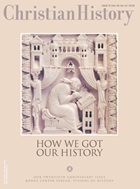When Eddius Stephanus, an Anglo-Saxon priest, sat down to write The Life of Bishop Wilfrid in the early decades of the eighth century, he mused, "This very task of preserving the blessed memory of Bishop Wilfrid is of great gain and value to myself. Indeed it is in itself a ready path to virtue to know what [Wilfrid] was." His goal was not merely to generate an historical record of Wilfrid's actions, but to strengthen his own faith and the faith of others.
Those spiritual and pedagogic concerns lie at the heart of the genre, or more properly genres, of "hagiography"—literally, "writings about saints." Thus a work of hagiography tells us at least as much about the author and his audience as it does about the saint who is its subject. Though often unreliable as factual history, hagiography nonetheless provides some of the most valuable records for understanding pre-modern Christianity.
Go and do likewise
Hagiography encompasses many types of literature, including Lives of saints, collections of miracle stories, accounts of the discovery or movement of relics, bulls of canonization, investigations into the life of a candidate for canonization, liturgical books, sermons, and visions.
Saints were quite literally holy men and women, and venerating them lay at the core of medieval Christianity. Saints demonstrated their holiness through their actions—the willingness to accept martyrdom, the rigors of extreme asceticism, the wise exercise of episcopal office, or the heroic defense of virginity.
With God's assistance, saints could draw on their holiness to perform miraculous actions, such as curing the sick, defeating their enemies without the use of force, and exorcising demons.
Those miraculous powers were not extinguished by death, for posthumously the saint became a resident of God's court. His or her intercessory powers could be invoked by living Christians through prayer and pilgrimage, donation and devotion.
The first Christians to be honored as saints were martyrs who died during Roman persecutions. The Martyrdom of St. Polycarp and The Passion of Sts. Perpetua and Felicity are two well-known hagiographical accounts from this initial period.
In the fourth and early fifth centuries, the burgeoning ascetic movement in the Egyptian desert provided a new ideal of sanctity. Around 360, Bishop Athanasius of Alexandria composed The Life of St. Antony of Egypt, celebrating one of the movement's earliest and most charismatic members.
The heart of the new hagiography was didactic, and the works sometimes produced dramatic effects. Augustine of Hippo (d. 430) counted the Life of St. Antony as a crucial influence in his conversion to Christianity and celibacy. Athanasius' Life was to remain a central reference point for all writers of hagiography, both eastern and western, throughout the Middle Ages. In the twelfth century, for example, such abbots as Bernard of Clairvaux (d. 1153) and Aelred of Rievaulx (d. 1167) were consciously described as imitators of their ancient predecessors.
Pieces of holiness
In 386 Bishop Ambrose of Milan (d. 397) discovered the relics of two martyrs, Gervasius and Protasius, and enshrined them in a church in the center of his city. While this was hardly the beginning of the public veneration of relics, Ambrose's actions excited widespread interest in the discovery and acquisition of new relics of martyrs.
About a decade later, Bishop Victricius of Rouen wrote In Praise of the Saints to commemorate the arrival in his remote diocese of several martyrs' relics. "Before today," Victricius wrote, "we carried our apostles and martyrs by faith. So the saints have come twice to Rouen. Then, they entered our chests; now they crowd the city's church." This text is one of the earliest pieces of hagiography to document the cult of relics.
From the ninth through the twelfth century, monasteries became the chief custodians of the cult of relics. An enormous monastic literature accumulated about the miraculous powers of saintly patrons. In Hrotsvit of Gandershim's The Establishment of the Monastery of Gandersheim, the bones of deceased saints and the actions of living holy women are central to the foundation and development of a community of nuns. In The Miracles of St. Ursmer on his Journey through Flanders, a group of monks take the relics of their patron saint on what amounts to a fundraising tour. And in The Book of Ely, the monks discuss how the miraculous powers of their long dead patron help them in the acquisition and defense of property.
Though immensely popular, these practices and the stories surrounding them were not universally accepted. Abbot Guibert of Nogent, a monk who fervently believed in certain saints' cults, produced one of the most sustained critiques in On Saints and Their Relics. He was particularly concerned that devotion to some reputed saints so far outstripped reliable knowledge that devotees might be seeking aid from drunks, charlatans, or apostates.
"Who, other than someone completely demented, would call upon such patron saints—about whom there remains not the slightest trace concerning their identity—as intercessors?" Guibert demanded. He also took issue with such absurdities as the claims by both Constantinople and Angély to possess the head of John the Baptist.
The road to sainthood
New religious movements developed in the thirteenth century that transformed the practice of the religious life, and with it the face of sanctity. Indeed, in western Christendom, the thirteenth century produced more Christians celebrated by their contemporaries as saints than any other period of the Middle Ages. One tally puts the number at over 500, of which a remarkably large portion—over a quarter—were women.
The proliferation of saints made clerics anxious about their control over the legends and cults. Beginning in the eleventh century, but decisively in the thirteenth, the papacy moved to take control of the means by which new saints were officially recognized.
Papal canonization involved legal inquiries into the lives of reputed saints, conducted by clerics who interviewed witnesses. These inquiries represent a new form of hagiography and one of the most precious sources for information about religious practice in the later Middle Ages.
The canonization process for Vincent Farrar (1350-1419), for example, included testimony from more than 200 witnesses in Brittany. While the inquest affords us a glimpse of the holy preacher at work, it also gives us a window into the lives of people from all walks of life in the mid-fifteenth century: their troubles, their hopes, their fears, their beliefs, and their relations with the holy.
A witness named Petrus Floc'h testified that Vincent had been an inspiring preacher (even when he was too weak to walk to the pulpit), a great influence on the community, and a committed ascetic. Several men and women spoke of Vincent's ability to revive dead people, including a boy who had drowned during a swimming lesson, a man who was beaten severely in a brawl, and an infant who had been "cut into two parts through his head" by his starving, pregnant mother, who planned to eat him.
The records from Vincent's canonization appear to be an exception, but by the fourteenth century, many inquests were highly scripted. Parties promoting the prospective saint's canonization would craft a biography, brief witnesses on the details, and then ask prepared questions. Even with such maneuvering, however, relatively few individuals achieved papal canonization—some 72 between 1198 and 1418.
Popular devotion
The cults of these new saints did not by any means supplant the cults of traditional saints. Indeed, the cults of many martyrs and other saintly patrons drawn from the early centuries of Christianity became even more important and widespread over the course of the later Middle Ages. Relics came to be displayed more prominently, and new fragments of saintly bodies were eagerly sought and placed in ornate reliquaries. Saintly legends were prominently displayed in stained-glass windows and painted triptychs.
Another means of encouraging the correct practice of Christianity, one developed particularly by the mendicant orders, was preaching. Preachers, ministering to the urban laity, needed collections of exemplary stories of a different sort than those produced for monastic novices. Stories for novices emphasized the order's traditions and ideals, while preachers' illustrations played off memorable details, such as the meaning of a saint's name, and expounded the everyday lessons that could be drawn from the saint's experiences.
Of the hagiographic collections gathered for preaching purposes, the most influential was the Golden Legend, completed by Jacopo da Voragine, an Italian Dominican, in 1258. Composed in Latin, it became available in virtually every vernacular language of western Christendom by the fifteenth century. These and the translations of many other works into the varied vernaculars dominated the hagiographic production of the later Middle Ages.
These "translations" were often very free in their rendering of the Latin originals. The authors of the vernacular legends frequently followed the style of contemporary epics and romances, although they also self-consciously attempted to produce a morally uplifting rival to such secular works.
The author of a Life of St. Barbara in Old French claimed, contrasting the heroines of her tale to the heroes of the popular Song of Roland, "I want to tell a new kind of story, / Never heard before. / Know that it does not concern Ogier, / Nor Roland, nor Olivier, / But a most holy maiden / Who was very courteous and beautiful."
The end of hagiography?
The varied reformations of the sixteenth century, both Protestant and Catholic, brought with them radical changes in the way people viewed saints. Protestant theologians and preachers rejected the idea of saintly intercession, which was considered a reliance on works rather than on faith. Reformers of all stripes—Desiderius Erasmus and Thomas More, Martin Luther and John Calvin—all composed, generally in the vernacular, critiques of the cult of relics.
In the Schmalkaldic Articles, Luther wrote, "The relics, in which there are found so many falsehoods and tomfooleries concerning the bones of dogs and horses, that even the devil has laughed at such rascalities, ought long ago to have been condemned, even though there were some good in them; and so much the more because they are without the Word of God; being neither commanded nor counseled, they are an entirely unnecessary and useless thing. But the worst is that [they have imagined that] these relics had to work indulgence and the forgiveness of sins [and have revered them] as a good work and service of God, like the Mass, etc."
Theological opposition often turned to violent iconoclasm during the Wars of Religion. Relic collections were destroyed, and the statues of the saints in many churches still bear the scars of attack.
In the mid-sixteenth century, the Council of Trent took many steps to reorganize the practice of the cult of saints and the means by which saints were canonized. Saints continued to be recognized in the Catholic church after the Reformation era, but at a slower pace and with greater circumspection. In the twentieth century, many saints' cults were suppressed for lack of historical support.
Protestants, for their part, never formally acknowledged saints and therefore never produced anything that could technically be called "hagiography," though the martyrologies of writers like John Foxe (see Model Martyrs, page 39) come close. Glowing biographies of missionaries and other heroes share some characteristics of hagiography as well—uncritical reporting of marvelous stories, didacticism, and an emphasis on providing models for readers to emulate. Wherever inspiration trumps investigation, hagiography echoes.
Thomas Head is professor of history at Hunter College and the Graduate Center, the City University of New York. He edited Medieval Hagiography: An Anthology (Garland, 2000), from which this article was adapted.
Copyright © 2001 by the author or Christianity Today/Christian History magazine.
Click here for reprint information on Christian History.

Support Our Work
Subscribe to CT for less than $4.25/month




























